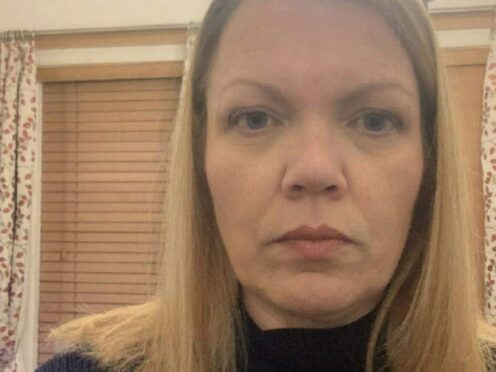
A primary school teacher accused of stabbing her partner to death “in cold blood” before burying his body in their garden has pleaded guilty to manslaughter.
Fiona Beal, 50, admits she killed her 42-year-old boyfriend Nicholas Billingham, whose partly mummified remains were discovered four-and-a-half months after he was last seen.
A jury at the Old Bailey heard on Friday that Beal pleaded guilty to the lesser offence of manslaughter by reason of a loss of control – but she denies she murdered Mr Billingham between October 30 and November 10, 2021.

Opening her trial, prosecutor Hugh Davies KC said: “There is no dispute that she killed Nick Billingham, concealed his body where it was found and acted alone throughout. There is no dispute that she intended to kill him.
“She has accepted that she is guilty of the lesser offence of manslaughter. She has pleaded guilty to that offence. She does not accept she is guilty of murder. Her defence is based on a so-called partial defence to murder.”
The teacher, of Moore Street, Northampton, was arrested in March 2022 after police discovered the body.
Forensic officers and specialist search teams were deployed to the address before the discovery was made.
The court heard her actions were revealed through journal entries discovered by police.
Mr Davies told jurors that Beal, “a high-functioning professional”, messaged several people on November 1, 2021 – and in the days after – that she and Mr Billingham had contracted Covid-19 and needed to isolate.
The prosecutor called the Covid narrative “sustained and dishonest” and told jurors there is “no evidence” that Beal took a PCR test.
The court heard similar messages were sent from Mr Billingham’s phone from November 2.
Mr Davies told jurors the messages from Mr Billingham’s phone was Beal “pretending to be him” in a move that was “as heartless as it was self-serving”.
On November 8, jurors heard Beal sent messages to her sisters that she and Mr Billingham had split up, with one message referencing he left because he had had an affair with another woman.
The prosecution said the narrative that Mr Billingham had run off with another woman was “completely false”.
But jurors heard Mr Billingham appeared to have cheated on Beal previously.
Beal returned to work “fully discharging her considerable responsibilities as a teacher to Year 6 pupils” and receiving a “sympathetic response” from people who had heard about her break-up.
Her mental health started to deteriorate in late February 2022, the court was told.
In March of that year, she rented a cabin for herself in Cumbria and sent messages to family members which gave them cause for concern over her wellbeing, prompting them to call police to check up on her, the prosecutor said.
In the cabin, police found journals “written in her hand” that showed “a wholly different side to her personality”.
Mr Davies said: “They certainly do contain some unambiguously clear declarations of what she had done. These parts were not just her truth, but the truth. What was this?
“The short answer is that she had planned to, and had, killed him in cold blood. She had purchased a forged handled utility knife in the days before. She had a chisel and cable ties.
“Promising sex after a bath, she stabbed him in the neck when he was wearing a sleep mask and was probably cabled-tied on their bed.”
The prosecutor continued: “Stated shortly, in all these documents Fiona Beal introduces themes of her having been controlled and manipulated in the relationship; of her insecurities having been exaggerated rather than helped by his attitude; of unpleasant things he had done… and this explaining why she killed him as she did.
“She introduces her insight into her own split personality, and an alter ego – i.e. her ‘second self’ – she calls Tulip 22, who is capable of wholly different and darker conduct than her public persona of committed teacher.”
Jurors heard one entry said: “Still my actions haunt me. I sometimes have to catch myself and remember what I did and then remember my cover story – neither seem convincing.”
Another detailed her planning for the attack, with Beal writing: “It was harder than I thought it would be. Hiding a body was bad. Moving a body is much more difficult than it looks on TV.”
The journals triggered a police investigation, which soon established that Mr Billingham had not been seen or spoken to by telephone since the afternoon of November 1 2021, the court heard.
“Having manufactured and sustained a cynical lie to everyone she messaged or spoke to about isolating for Covid, Fiona Beal had planned and ensured that she had the house to herself for at least 10 days after the killing,” Mr Davies told jurors.
“She used this time to purchase multiple items to enable her to dispose of his body.
“Acting throughout on her own, she wrapped her dead partner up and dragged him down the stairs, destroying the banister rails upstairs in order to do so. He was 5ft 11in and weighed some 14 stone – even when recovered months later.
“She buried him in the side return of her garden.”
Mr Davies described how Mr Billingham’s “grave” comprised of concrete she had mixed and a “de facto coffin” made of breeze blocks, timber and sheets.
He called it a “major job” which required planning.
“Planning, executing, deceiving: a habitual pattern,” Mr Davies said.
The court heard that this is the second time a trial has started for these matters, with a different jury – for a trial that took place in Northampton last year – discharged before the end of the evidence for legal reasons.
The trial continues on Monday.

Enjoy the convenience of having The Sunday Post delivered as a digital ePaper straight to your smartphone, tablet or computer.
Subscribe for only £5.49 a month and enjoy all the benefits of the printed paper as a digital replica.
Subscribe